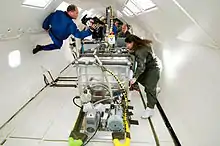Electron-beam freeform fabrication
Electron-beam freeform fabrication (EBF3) is an additive manufacturing process that builds near-net-shape parts requiring less raw material and finish machining than traditional manufacturing methods. It uses a focused electron beam in a vacuum environment to create a molten pool on a metallic substrate.

History
The use of electron beam welding for additive manufacturing was first developed by Vivek Davé in 1995 as part of his PhD thesis at MIT.[1] The process was referred as electron beam solid freeform fabrication (EBSFF). NASA Langley Research Center (LaRC) developed the process further calling it electron beam freeform fabrication (EBF3). The additive manufacturing process was primarily developed and engineered by Karen Taminger, material research engineer for NASA LaRC. EBF3 is a NASA-patented additive manufacturing process designed to build near-net-shape parts requiring less raw material and finish machining than traditional manufacturing methods. EBF3 is a process by which NASA plans to build metal parts in zero-gravity environments; this layer-additive process uses an electron beam and a solid wire feedstock to fabricate metallic structures. The process efficiencies of the electron beam and the feedstock make the EBF3 process appropriate for in-space use. Since 2000, a team of researchers at the NASA LaRC have led the fundamental research and development of this technique for additive manufacturing for metallic aerospace structures. Additive manufacturing encompasses processes in which parts are built by successively adding material rather than by cutting or grinding it away as in conventional machining. Additive manufacturing is an outgrowth of rapid-prototyping techniques such as stereolithography, first developed for non-structural plastic parts over 30 years ago.[2]
Process
The operational concept of EBF3 is to build a near-net-shape metal part directly from a computer-aided design (CAD) file. Current computer-aided machining practices start with a CAD model and use a post-processor to write the machining instructions (G-code) defining the cutting tool paths needed to make the part. EBF3 uses a similar process, starting with a CAD model, numerically slicing it into layers, then using a post-processor to write the G-code defining the deposition path and process parameters for the EBF3 equipment.[3] It uses a focused electron beam in a vacuum environment to create a molten pool on a metallic substrate. The beam is translated with respect to the surface of the substrate while metal wire is fed into the molten pool. The deposit solidifies immediately after the electron beam has passed, having sufficient structural strength to support itself. The sequence is repeated in a layer-additive manner to produce a near-net-shape part needing only finish machining. The EBF3 process is scalable for components from fractions of an inch to tens of feet in size, limited mainly by the size of the vacuum chamber and amount of wire feedstock available.[4]
See also
References
- Davé, Vivek Ramesh (1995). Electron beam (EB)-assisted materials fabrication (Thesis thesis). Massachusetts Institute of Technology. hdl:1721.1/11505.
- https://ntrs.nasa.gov/archive/nasa/casi.ntrs.nasa.gov/20080013538_2008013396.pdf Electron Beam Freeform Fabrication for Cost Effective Near-Net Shape.
- http://www.nasa.gov/topics/aeronautics/features/electron_beam.html From Nothing, Something: One Layer at a Time.
- http://www.techbriefs.com/content/view/478/34/Portable Electron-Beam Free-Form Fabrication System.